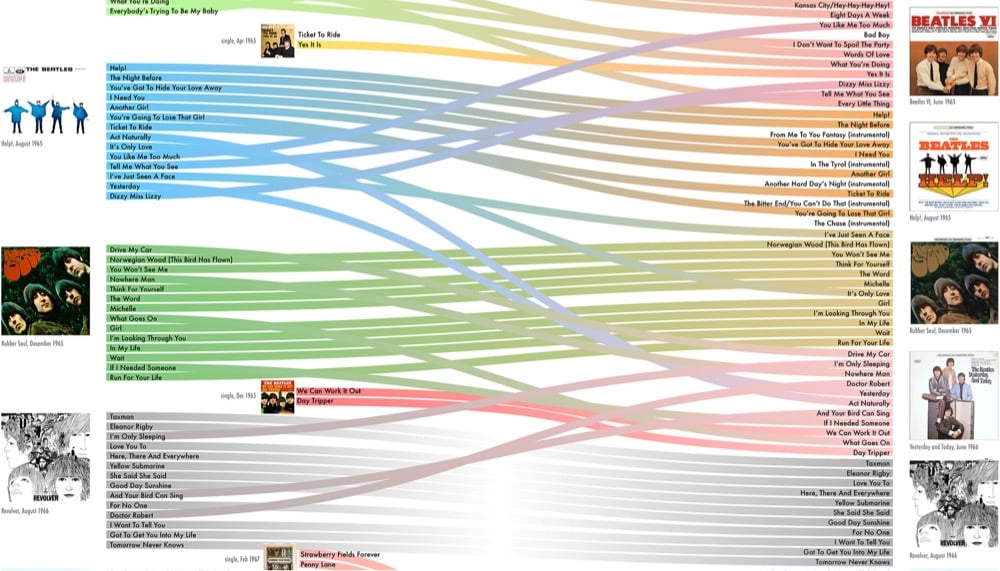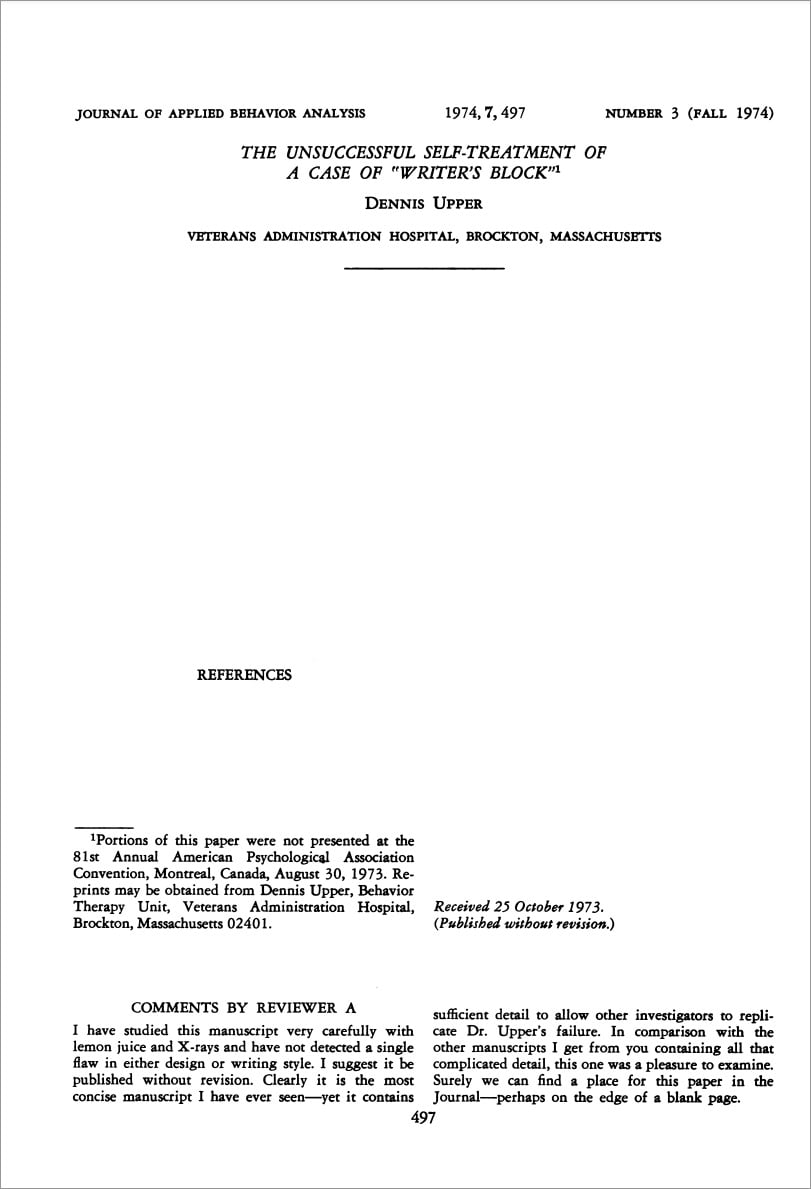


This site is made possible by member support. 💞
Big thanks to Arcustech for hosting the site and offering amazing tech support.
When you buy through links on kottke.org, I may earn an affiliate commission. Thanks for supporting the site!
kottke.org. home of fine hypertext products since 1998.
Entries for February 2022
Very Abstract Pixel Art
![]()
From former Nintendo art director Takashi Maeda, a collection of very abstract pixel art that’s free to download and use. (via @presentcorrect)
A pair of recent preprints asserts that “the Huanan market [in Wuhan] was the epicenter of SARS-CoV-2 emergence” and “SARS-CoV-2 emergence very likely resulted from at least two zoonotic events”. Basically: not a lab leak.
10 Minutes of Fascinating Deep-Sea Animals
From the Monterey Bay Aquarium Research Institute, a 10-minute video of fascinating deep-sea animals like the strawberry squid, black seadevil anglerfish, psychedelic jelly, and Pacific blackdragon. Amazing, fantastical creatures. (via colossal)
Red Sprites and Blue Jets: Massive Luminous Displays in Stormy Skies
Sometimes the sky above powerful thunderstorms can light up in massive displays of color; they’re called transient luminous events. Whoa, I’ve never seen or heard of this phenomenon before!
On rare nights with clear visibility over powerful distant thunderstorms, you might be able to see and capture red sprites. Sprites are large scale electrical discharges occurring high above thunderstorms in the upper atmosphere. They are massive events, sometimes 50 kilometers tall by 50 kilometers wide. Sprites belong to a mysterious and colorful group of phenomenon called Transient Luminous Events, or TLEs. Other TLE’s include halos, Elves, trolls, secondary jets, Blue starters, Blue jets and the magnificent gigantic jets. But what exactly are these transient luminous Events, and how do they form?
This video is a great explainer about the phenomenon — how it arises, where the colors come from, etc. (via the kid should see this)
You Can Have Geothermal Power Everywhere If You Drill Deep Enough. A new startup says it can access the Earth’s virtually unlimited geothermal energy almost anywhere by using a microwave drilling technique that can reach 12 miles down.
Catwoman vs. the White House
In 1968, singer, actress, and activist Eartha Kitt was invited to a “Women Doers” luncheon at the White House by Lady Bird Johnson, the First Lady. Kitt’s focus on actual problems and solutions didn’t jibe well with the self-congratulatory platitudes of a DC working luncheon. First she pointedly questioned a caught-off-guard President Johnson about childcare for working parents after he stopped by to gladhand a little bit. Then, after remarks from several other women in the room, Kitt rose and spoke out against the war in Vietnam:
The children of America are not rebelling for no reason. They are not hippies for no reason at all. We don’t have what we have on Sunset Blvd. for no reason. They are rebelling against something. There are so many things burning the people of this country, particularly mothers. They feel they are going to raise sons — and I know what it’s like, and you have children of your own, Mrs. Johnson — we raise children and send them to war.
After the luncheon, Kitt’s career in the United States took a turn for the worse.
A Regular Guy Tries to Compete at Olympic-Level Curling
In this video, complete curling novice Clay Skipper spends a day getting trained up by some of the best curlers in world and then tries to apply what he’s learned in a doubles match. This is actually really interesting and well-done — not only do you get a good overview of the rules and strategy of curling, you also see the progression of coaching & learning, from the basic approach (that will get the stone down the pitch) to fine-tuning techniques to reliably place your shots where you want them. Oh, and you can see just how difficult it is to play at a high level.
How to Make Potatoes While Dread Presses In from Every Direction
John Green shares his technique for roasting potatoes while fighting “the creeping sense of dread” that many of us may be experiencing right now.
All right, let’s make some potatoes. You want enough potatoes that they will sustain the sack of flesh that contains your soul for several hours. And ideally you want these little red potatoes, which you then cut into sixths — or eighths if they’re too big. Don’t overthink the size of your potato wedges but also don’t underthink it. This is the key not just for cooking but also for most things.
(via @jackisnotabird)
The Biden administration has nominated Ketanji Brown Jackson for the vacant Supreme Court seat. Here’s a short profile of Jackson and why she was chosen.
From military historian Bret Devereaux: Understanding the War in Ukraine. The invasion was planned months ago, Putin was never going to negotiate, NATO had limited options before the invasion.
John Oliver Explains Critical Race Theory
I don’t know if it was the plan for Last Week Tonight with John Oliver to become Funny Cliffs Notes for Important Social Issues in the Failing States of America, but here we are. On this week’s Last Week, Oliver explains the “manufactured panic” around critical race theory in America.
How American Conservatives Turned Against the Vaccine
From Vox’s Joss Fong, a video essay on how conservatives turned against the Covid-19 vaccine in the US.
President Donald Trump presided over the fastest vaccine development process in history, leading to abundant, free vaccines in the US by the spring of 2021. Although the mRNA Covid-19 vaccines haven’t been able to stop transmission of the virus, they have been highly effective against hospitalization and death, saving hundreds of thousands of lives and rendering the majority of new Covid-19 deaths preventable.
Trump has received three doses of the vaccine. But many of his most dedicated supporters have refused, and many have died as a result. Why? Obvious culprits include misinformation on social media and Fox News and the election of Joe Biden, which placed a Democrat at the top of the US government throughout the vaccine distribution period. But if you look closely at the data, you’ll see that vaccine-hesitant conservatives largely made up their mind well before the vaccines were available and before Donald Trump lost the 2020 election.
Fong makes a compelling argument for the potential genesis of conservative vaccine denial: early on in the pandemic, in February and March 2020, prominent conservative leaders and media outlets (like Trump and Fox News) told their constituents that the threat of the pandemic and of SARS-CoV-2 has been exaggerated by journalists and liberal politicians. So, in the mind of a Fox News viewer, if the pandemic is not such a big deal, if it is “just the flu”, then why would you want to get vaccinated? Or wear a mask? Or take any precautions whatsoever? Or, most certainly, why wouldn’t you be angry at you and your kids (your kids!) being forced to do any of those things?
The Russian Invasion of Ukraine
Good morning, everyone. As you have likely heard, Russia invaded Ukraine earlier today. Here’s the news from Reuters, NY Times, Associated Press, and CNN. From Reuters:
Russian forces invaded Ukraine on Thursday in a massed assault by land, sea and air, the biggest attack by one state against another in Europe since World War Two.
Missiles rained down on Ukrainian cities. Ukraine reported columns of troops pouring across its borders from Russia and Belarus, and landing on the coast from the Black and Azov seas.
Although I hope I’m wrong, this is not likely to end well for anyone and my thoughts are with the people of Ukraine, those in nearby countries, and also with Russian citizens & soldiers who will bear the consequences for the actions of their “leadership”.
So I wanted to get that out there but also to acknowledge that I don’t know how much I will be talking about this on the site, even though it’s potentially such a big deal. There have never been any hard and fast rules about what goes on the site or not. I am not a journalist and I generally don’t cover current events and news here — but sometimes I do. The pandemic has been a massive exception in that regard over the past two years — it felt irresponsible not to talk about it here, link to resources, amplify expert advice & opinion, and attempt to counter deliberate and deadly misinformation. There are going to be much better sources of news, information, opinion, and analysis about the situation in Ukraine than kottke.org, so I’m going to largely leave them to it. Also, I have not been feeling super sturdy lately, and I’m not sure diving into WWIII is the best thing for me to be doing right now.
Again, just wanted to acknowledge that in case you were wondering why I’m not covering “the biggest attack by one state against another in Europe since World War Two”. Be safe out there, everyone.
Tarantino’s Fan Fiction: Once Upon a Time in Hollywood
From Kirby Ferguson (Everything is a Remix), a short video essay about how Quentin Tarantino remixed reality in Once Upon a Time in Hollywood.
Quentin Tarantino is well-known for mashing up different movies into his own. The peak of this method is Kill Bill, which is loading with bits taken from other films. Since then, Tarantino seems to have changed — there hasn’t been nearly so much obvious copying in his movies. But actually he’s still doing the same thing. He’s just copying in a different way, and the sources he copies from are less often movies and more often reality.
My 24-Hour Experiment With Dystopian Food Units. “When you generate a square-shaped facsimile of asparagus that tastes exactly like asparagus but doesn’t feel like asparagus, it’s a little horrifying.”
The Overthrow of Hawaii
In this TED-Ed video, Hawaiian scholar Sydney Iaukea tells the abbreviated story of how Hawaii came to be a territory of the United States.
On January 16th, 1895, two men arrived at Lili’uokalani’s door, arrested her, and imprisoned her. The Missionary Party had recently seized power and now confiscated her diaries, ransacked her house, and claimed her lands. Lili’uokalani was Hawaii’s queen and she ruled through one of the most turbulent periods of its history. Sydney Iaukea shares how the ruler fought the annexation of Hawaii.
Inside the Super Positive Community of Competitive YouTube Water Drinkers. “You do kinda have to follow some rules — it’s not just laissez-faire hydration out there.”
Colorful Wavy Portraits by Foster Sakyiamah



These striking portraits are by Ghanaian artist Foster Sakyiamah. You can check out more of his work on Instagram.
“Have you ever wondered how a book becomes a book?” Great look at the printing process for Marlon James’ Moon Witch, Spider King.
Yes, this, exactly: who gives a shit about plot holes in a movie when the rest of it works? Plot killjoys begone!
Inside the Underground Economy of Solitary Confinement. How prisoners undergoing the torture of solitary confinement “use their ingenuity, collaboration skills and a form of ‘fishing’ to get what they need”.
How Long Covid Exhausts the Body. “Studies estimate that perhaps 10 to 30 percent of people infected with the coronavirus may develop long-term symptoms.”
The Winners of 2021 International Landscape Photographer of the Year Contest




All of the winners and shortlisted entries of the 2021 International Landscape Photographer of the Year contest look fantastic, but I managed to pull out a few favorites. From top to bottom, photos by Tanmay Sapkal, Wayne Sorensen, Takashi Nakazawa, and Tom Putt.
You can view the winners online, or in PDF form.
Tom Holland lip syncing to Rihanna always cheers me up. Instant mood lifter.
An Explanation of the US Interstate Numbering System
From CGP Grey, here’s an explanation of the numbering system used by the US Interstate Highway System. Here’s the basic deal, from Wikipedia:
Primary Interstates are assigned one- or two-digit numbers, while shorter routes (such as spurs, loops, and short connecting roads) are assigned three-digit numbers where the last two digits match the parent route (thus, I-294 is a loop that connects at both ends to I-94, while I-787 is a short spur route attached to I-87). In the numbering scheme for the primary routes, east-west highways are assigned even numbers and north-south highways are assigned odd numbers. Odd route numbers increase from west to east, and even-numbered routes increase from south to north (to avoid confusion with the U.S. Highways, which increase from east to west and north to south).
In-car and on-phone GPS systems have made knowing this system largely irrelevant for most drivers. I spent a lot of time in the car as a kid — summer roadtrips around the country and frequent local travel out of our rural area — and loved maps & atlases even at that age, so this was pure nostalgia for me. The video covers some of the numbering exceptions at the end (like the 35E/35W split in the Twin Cities I used to drive on often), but I would easily have sat through 10 more minutes of them.
The Stairs of Alfred Hitchcock
Stairs show up all over the place in Alfred Hitchcock’s movies — here’s a supercut of some of those scenes from his more than 50 years of movie-making.
In the first shot of Alfred Hitchcock’s first film, The Pleasure Garden (1925), a line of women stream down a spiral staircase backstage at a theater. In the last shot of Hitchcock’s last film, Family Plot (1976), Barbara Harris sits down on a staircase, looks into the camera, and winks. In the fifty years and over fifty films between these bookends, Hitchcock made the staircase a recurring motif in his complex grammar of suspense — a device by which potential energy could be, metaphorically and literally, loaded into narrative, a zone of unsteady or vertiginous passage from one space to another, always on the verge of becoming a site of violence.
(via storythings)
La Demoiselle d’Instagram
Using an app called Prequel, Savannah Cordova ran a portrait of herself through the app’s Cartoon filter several times, which smoothes out facial features and increases the level of abstraction. The first pass turned her into a Disney/Pixar-esque character:

But after 10 rounds of filter reapplication, Cordova’s portrait is in solid Picasso territory:

See also more feedback loops in audio (I Am Sitting in a Room) and video (I Am Sitting in a Room (with a video camera) and Dueling Carls).
An American gun company is selling an AR-15 for kids that “operates just like Mom and Dad’s gun”. A semi-automatic assault rifle for children…this is sick.
Alien in 60 Seconds
In just one minute and with what seems like a budget of only $60, these folks made their own version of Alien. The effects, they are certainly special. Remember sweded films? (via digg)
A report on how the city of Montreal deals quickly and decisively with all the snow they get during a typical winter. “Sidewalks, bike paths, and streets are all cleared in a snow removal effort that is choreographed and masterful.”
The dystopian Winter Olympics. “With their spectacle of extreme athletics held against a backdrop of climate emergency, public health disaster, political brinkmanship and rampant corruption, the Games reek of societal decline.”
A comprehensive guide to understanding, producing, and using olive oil from a small California producer called Fat Gold. “Olive oil is best understood as the fresh fruit juice of the olive.”
How Insulated Glass Changed Architecture
Before the invention of insulated glass (i.e. double-paned windows) in the 1930s, builders and architects had to balance bringing light into a structure with keeping heat transfer to a minimum. For buildings in most climates, that resulted in the use of small windows and not a lot of natural light. Insulated glass meant you could keep the heat in (or out) while letting in large amounts of light and this changed how both residential and commercial buildings were built. (via the morning news)
The Moral Danger of Declaring the Pandemic Over Too Soon. “What would it mean to move into a future in which a common fate mattered as much as our own?”
Currently about 190,000 people watching this livestream of airliners landing at London Heathrow in a whopper of a storm. Lots of sideways flying and landing.
Slow Motion Helicopter Blade Rotation
Here’s what a whirring helicopter blade looks like, from the perspective of a GoPro strapped to the blade. The video is in slow motion — shot at 240 fps and displayed at 30 fps. Here’s what the blade looks like in flight and upside-down while doing a flip. (via clive thompson)
Do You Know Where You’re At?

In 1981, Coevolution Quarterly published a 20 question quiz written by Leonard Charles, Jim Dodge, Lynn Milliman, and Victoria Stockley that is designed to reveal how well you know your local natural environment. Here are the questions:
- Trace the water you drink from precipitation to tap.
- How many days til the moon is full? (Slack of 2 days allowed.)
- What soil series are you standing on?
- What was the total rainfall in your area last year (July-June)? (Slack: 1 inch for every 20 inches.)
- When was the last time a fire burned in your area?
- What were the primary subsistence techniques of the culture that lived in your area before you?
- Name 5 edible plants in your region and their season(s) of availability.
- From what direction do winter storms generally come in your region?
- Where does your garbage go?
- How long is the growing season where you live?
- On what day of the year are the shadows the shortest where you live?
- When do the deer rut in your region, and when are the young born?
- Name five grasses in your area. Are any of them native?
- Name five resident and five migratory birds in your area.
- What is the land use history of where you live?
- What primary ecological event/process influenced the land form where you live? (Bonus special: what’s the evidence?)
- What species have become extinct in your area?
- What are the major plant associations in your region?
- From where you’re reading this, point north.
- What spring wildflower is consistently among the first to bloom where you live?
People living here 200 years ago — or even 75-100 years ago — would definitely have known all of these and many currently living in the area, especially those who have lived here much longer that I have, would know most of this. Being mostly an indoorsman, I am only am aware of some of these, and even then only partially. How well do you know your local environment?
I found the quiz in Rob Walker’s newsletter and he added a helpful exercise for us low-scorers:
Pick one of the questions you don’t know the answer to - and make it a point to learn what that answer is. After you’ve mastered that, move on to a new question.
I chose the question about soil series and learned that the state of Vermont has an official State Soil: Tunbridge soil.
The Tunbridge series consists of loamy, well-drained soils that formed in Wisconsin-age glacial till. These soils are 20 to 40 inches deep over schist, gneiss, phyllite, or granite bedrock. They occur extensively in mountainous areas of Vermont, in all but one county.
Tunbridge soils are used mainly for woodland. White ash, American beech, white birch, yellow birch, hemlock, white pine, red spruce, red maple, and sugar maple are typical species. Sugar maple is especially important; Vermont produces the largest amount of maple syrup in the U.S. Some areas have been cleared and are used for hay and pasture. Recreational uses are common on these soils. They include trails for hiking, mountain biking, snowmobiling, and skiing.
Neat!
Update: See also The Big Here Quiz for more questions and the origin story of such lists.
Update: Turns out I posted about this almost 16 years ago (and forgot about it). (thx, john)
Paris has announced their plan for a car-free zone. With exceptions, cars will not be allowed in much of 1st-4th arrondissements (and parts of the 5th-7th) starting in 2024.
The Broken Tech/Content Culture Cycle

Anil Dash writes about the 24 stages of the growth-fueled “broken tech/content culture cycle” that VC-driven Silicon Valley (among other places) has pioneered over the past 15 years. Here’s how you begin:
1. Build a platform which relies on cultural creation as its core value, but which only sees itself as a technology platform. Stick to this insistence on being solely a “neutral” tech company in every aspect of decision-making, policy, hiring and operations, except for your public advertising, where the message is entirely about creativity and expression.
2. Hire a team that’s rewarded solely on growth goals and winnow out anyone who values creators or culture above expansion and user acquisition. Enforce a monoculture.
And then:
8. Build an algorithm to “surface great content” for your audience. Train it on the behaviors of your existing creators, so you create a rich-get-richer dynamic, effectively cementing the culture of your platform and making it impossible for new creators from underrepresented communities to get a foothold. Make it so the only process for revisiting your algorithm is bad-faith arguments from right-wing goons trying to game the refs because their actual content isn’t good enough to get audience on its own. After that, treat the algorithm as some magical sacrosanct god with unknowable whims that everyone is subject to, rather than as a series of intentional business decisions captured in software form.
Eventually:
18. Double down on funding the worst voices on your platform. Call it “free speech”, and make sure that nobody internally points out that truly defending free speech would have entailed protecting those early marginalized creators who made your platform credible in the first place.
19. Definitely misuse “free speech” as a rhetorical bludgeon against people who are pointing out that you are both amplifying and sponsoring content, not merely making it available. Resolutely refuse to be intellectually honest about the difference between merely providing a platform to all, vs. making editorial decisions to promote and subsidize content that you have control over.
Spotify, Substack, Google, Twitter, Amazon, Apple, Facebook, Reddit…this predictable script has played out at all of these companies in some form or another over the past decade.
Great profile of Venus and Serena Williams by @tressiemcphd. “…those braids said everything we needed to know. They were Black like how I was Black.”
When the Giant Cruise Ships Came to Town
Over the last decade, cruise ships began to visit the city of Stavanger, Norway. Soon, their size and the frequency of their visits began to dwarf the scale of the city’s center. Stavanger resident, filmmaker, and poet Odveig Klyve made this short silent film about these massive visitors.
The vistas from Stavanger are striking: sparkling ocean, with islands and mountains in the distance. Recently, however, a new industry’s arrival has obstructed the view and, as Klyve put it, changed the very feeling of the city. When cruise ships first came to the harbor, about ten years ago, Klyve remembers her neighbors being excited about the important economic boost that tourists would bring to the area; some residents even put up banners to welcome visitors into their gardens. Over time, however, the cruise industry has become a local controversy.
The ships have become more frequent — and much, much larger. The liners that pull into the harbor now are so tall and broad that they block out views entirely, fundamentally changing Stavanger’s atmosphere. “It takes away the sun,” Klyve told me. “It takes away the air. It’s claustrophobic.” And with the increased commerce has come noise and pollution. Klyve said that some of her harborside neighbors now have to wash their white-painted houses, which go gray because of the smog. Others simply miss being able to see the sea. In summer, up to five cruise ships pull into the harbor every day.
This wasn’t mentioned in the article accompanying the video, but one of the reasons the ships’ scale is so out-of-whack with the buildings in the city’s center is due to cultural preservation:
Stavanger’s core is to a large degree 18th- and 19th-century wooden houses that are protected and considered part of the city’s cultural heritage. This has caused the town centre and inner city to retain a small-town character with an unusually high ratio of detached houses.
The population of Stavanger’s metropolitan area is almost 320,000 and if you look at a satellite map of the city, there are massive docks and heavy industry just across the bay from the city’s core. But the satellite also caught a ridiculously gigantic cruise ship docked next to a neighborhood of small houses and the waterfront is just jam-packed with people disgorged from the ship’s innards. It’s a real metaphor for something and probably not a great environment for the people who live there.
After 16-year-old Nicolas Montero’s anti-vaxxer parents forbid his Covid vaccination, he got the shots without parental consent (per Philly law). The parents found out after they got Covid and he didn’t.
“I decided to make my own version of no-knead bread by replacing a key ingredient, water, with a classic electrolyte-replenishing, thirst-quenching beverage: Gatorade.” It’s what bread-eaters crave!
US Beatles Albums Weren’t the Same As UK Beatles Albums
Throughout the relatively short recording career of The Beatles, and as late as 1967’s Magical Mystery Tour, the band’s albums released in the United States were, in some cases, quite different than those released in the UK. Jared Pike explains the differences in this comprehensive video:
Pike also made a chart of all the releases and which albums they appeared on, which you can download here. The image is too tall to include here, but here’s an excerpt that shows some of the reorganization that was done for American audiences:

I just looked on Spotify here in America and they’re using the UK versions of the albums (at least for Rubber Soul and Revolver). I wonder how long that’s been the case? According to Wikipedia, it looks like when the band’s albums were reissued on CD in 1987, the track listings were standardized to the UK/international release.
Reader Comments for The New York Times’ “Homestyle Spaghetti Carbonara” Recipe. “Is it OK to use Romano cheese instead of Parmesan? And if I don’t have spaghetti on hand, can I just use fish?”
The History of Blue Jeans
This is a short clip of a PBS American Experience episode called Riveted: The History of Jeans. It traces the origin of blue jeans back to India and Europe:
James Sullivan, Author: We’re not quite sure exactly where the fabric originated, but there are several hints: One is Dungri, India, where as early as the 17th century, they were creating a coarse cloth for workers, eventually called dungaree. There’s the Genoans of Italy, who had a certain type of sail cloth that was eventually fashioned into work pants. And there’s Nimes, France where the cloth there was known as “serge de Nimes.” Not always but very often, these various types of cloth were dyed blue. Probably to hide dirt as much as anything.
Rabbit Goody, Weaver: So, we have blue “jean” from Genoa, we have blue “de Nimes” or denim coming from Nimes but when we make it into pants in America, we end up morphing the garment into blue jeans.
When denim came to America, much of the labor to produce it and knowledge of the process for dying it blue came from enslaved people who had been working with indigo for hundreds of years in Africa:
Daina Berry, Historian: In fact we know the names of all the enslaved people that were owned by the Lucas and Pinckney family. These are generations of families. We’re not just talking about a husband and a wife, or a mom and a dad. We see grandparents on this list. They’re the ones that came from communities that dyed all kinds of cloth beautiful colors. They’re the ones that had the knowledge of indigo; they’re the ones that created generations of wealth for these white slave-holding families.
Evan Morrison, Collector: Back in the 19th century denim really dominated because it’s a strong weave. So with the rise in durable cotton goods, denim made itself the accepted second skin in terms of cloth that was put into clothing meant for laborious work.
Seth Rockman, Historian: So as American cotton manufacturing begins to sort of find its footing in the 18-teens and 1820s, mills in Rhode Island, mills in Massachusetts, mills in New Hampshire, they need a source of cotton. And the only source of cotton that’s available to make these mills economically viable is cotton that’s being grown by enslaved men, women, and children in the American South.
If you’re in the US, you can watch the entire episode on PBS or on the PBS website.
Dr. Jen Gunter on why she reported Dr. Oz to his state medical board. “We can no longer allow doctors who are driven by conspiracy theories, financial gain, and political motives to harm people by providing lies…”
Jonny Greenwood Pretended to Play the Keyboard When He First Joined Radiohead
This is the kookiest thing I have heard all week: Jonny Greenwood didn’t know how to play keyboard when he first joined Radiohead (when the band was still called On a Friday). Here’s what he told Terry Gross on a recent episode of Fresh Air:
Well, they had a keyboard player who — Thom’s band had a keyboard player, which I think they didn’t get on with because he played his keyboard so loud. And so when I got the chance to play with them, the first thing I did was make sure my keyboard was turned off when I was playing. And I must have done months of rehearsals with them with this keyboard that was just — they didn’t know that I’d already turned it off and was just — they made quite a racket, quite a noise. It was all guitars and distortion.
And so I would pretend to play for weeks on end. And Thom would say, I can’t quite hear what you’re doing. But I think you’re adding a really interesting texture because I can tell when you’re not playing. And I’m thinking, no, you can’t, because I’m really not playing. And I’d go home in the evening and work out how to actually play chords. And cautiously, over the next few months, I would start turning this keyboard up. And that’s how I started — you know, started in with Radiohead.
To be fair, Greenwood knew how to play music (the recorder and viola for a start), he just didn’t know how to play the keyboard. Fake it til you make it, I guess!
A Robotic Caterpillar Slowly Climbs a Woodpile
This is almost beyond meditative: watch Reuben Margolin’s robotic caterpillar very slowly scale a woodpile.
The woodpile is not as random as it looks, but follows a predetermined polynomial spline within certain bounds of curvature. It is made of scrap wood and took about week to make. The caterpillar took several months, although a lot of that time was spent learning about servo motors, micro-controllers, Terminal and Python, and learning how to use an oscilloscope to trouble shoot the square wave signal that carries the angular information.
(via clive thompson)
“OK Computer but Everything Is My Voice”
YouTuber shonkywonkydonkey takes songs and reworks them using only his voice — all the original instruments, vocals, sound effects, etc. are replaced by his vocals. The results are waaay better than you would expect. His magnum opus is probably the entire album of Radiohead’s OK Computer (yes, all 53 minutes, 26 seconds of it):
I am also partial to Everything In Its Right Place:
Hard to Explain by The Strokes is great too:
You can check out the rest of his efforts here. (via @aaroncoleman0)
Letterpress Prints of Birds Printed Using Lego Bricks




Designers Roy Scholten and Martijn van der Blom have created a series of letterpress prints of birds made by using Lego pieces as the stamps (in lieu of lead or wood blocks). Letterpress, birds, Lego…that’s gotta be close to a bingo on many a designer’s card. (via colossal)
In January 2022 in Norway, about 84% of new cars sold were EVs. That compares to 53% in Jan 2021.
Titanic with a Cat
What if Titanic, but with a cat in a leading role alongside Leonardo DiCaprio? This is pitch-perfect, right down to the post-credits scene.
See also Paddington in Film. (via waxy)
An Unbelievably Tiny RC Car
YouTuber diorama111 took a 1/87 scale model car — about the size of a Jolly Rancher — and converted it into an incredibly small RC car that’s controlled via Bluetooth and even has working headlights, tail lights, and turn signals. It’s rechargeable too — the charging light turns green when the battery is full. (via @willhains)
Why did the countries “most prepared” for a pandemic have the worst outcomes? “Rich countries had the policies in place [but] most refused to enact them for fear of endangering the economy they depended on, and the libertarian policies that underpin it.”
Why does the US government stockpile so much cheese in huge caves underneath Missouri? Because the US subsidizes the dairy industry, resulting in massive overproduction in an age of falling consumption.
Fun Online Traffic Simulator


Oh wow, I spent far too much of my time this afternoon playing with this online traffic simulator. You can place stoplights, click to slow down traffic, change speed limits, modify traffic flow rates, etc. The source code for the simulator is available at Github so you can tinker with it.
See also Play Urban Street Designer with Streetmix and The Rates of Traffic Flow on Different Kinds of 4-Way Intersections.
To reduce Covid-19 deaths in the US, we should more aggressively vaccinate the elderly w/ the full 3-shot series. “Even the vaccinated and unboosted elderly are still dying of COVID at four times the rate of unvaccinated adults under 49.”
Measles Makes Your Immune System Forget Its Protections Against Past Illness
Historically, contracting the measles has been linked to subsequent illness (and possibly death) from other causes. In the past few years, scientists have discovered why this is: measles causes “immune amnesia”.
Enter “immune amnesia”, a mysterious phenomenon that’s been with us for millennia, though it was only discovered in 2012. Essentially, when you’re infected with measles, your immune system abruptly forgets every pathogen it’s ever encountered before — every cold, every bout of flu, every exposure to bacteria or viruses in the environment, every vaccination. The loss is near-total and permanent. Once the measles infection is over, current evidence suggests that your body has to re-learn what’s good and what’s bad almost from scratch.
“In a way, infection of the measles virus basically sets the immune system to default mode,” says Mansour Haeryfar, a professor of immunology at Western University, Canada, “as if it has never encountered any microbes in the past”.
This re-learning process takes up to three years, which “around the time it takes infants to acquire immunity to everyday pathogens in the first place”. In the meantime…
It’s not surprising, then, that measles doesn’t just increase the risk of illness, but also death. In fact, childhood mortality from other viruses is strongly linked to the incidence of measles. The 2015 study showed that when childhood mortality in the UK, US, or Denmark goes up, this is usually because measles has become more prevalent.
The findings explain why vaccinating children against measles has the unexpected, beneficial side-effect of reducing deaths among children, way beyond the numbers who were ever at risk of dying from measles itself.
Of course, an extremely effective and safe vaccine offers protection against both measles and the immune amnesia it causes. But with the steep rise in anti-vaccination sentiment during the pandemic and the increasing willingness of conservative leaders to disregard public health protections in favor of “individual freedom”, widely vaccinating against this dangerous pathogen in the US & elsewhere will be more difficult than in the past.
A ranking of all 32 Steven Spielberg movies, from best to worst. The top 10 includes Close Encounters, Jaws, ET, Jurassic Park, and Schindler’s List.
AI Creates Photorealistic Portraits of Cartoon Characters





Using AI image processing software, Hidreley Diao creates photorealistic portraits of familiar cartoon characters. The one of Moe from The Simpsons is kind of amazing — he’s got the look of a long-time character actor who’s developed so much depth over the years that he starts getting bigger roles and everyone’s like, this guy is actually kind of enigmatic and attractive and fantastic.
You can find more of his efforts on Instagram, where he also makes AI-assisted portraits of people we don’t have photos of (e.g. Michelangelo) and fictional people (e.g. Hercules and the Statue of Liberty).
See also the “Reverse Toonification” of Pixar Characters and What Homer Simpson Would Look Like in Real Life.
Every Episode of a Television Show Written by Julian Fellowes. “BUTLER: Madame, may I please escort you quickly back to your proper household area before you get any working class on you?”
Graphs Built With Townscaper Buildings

This is neat: Clive Thompson built a little app that converts tabular data into a bar chart using houses from the video game Townscaper. Says Thompson:
A few days ago I was placing houses in a long row, with varying heights. And when I looked at the jagged result I thought:
Hey, that looks like a bar chart!
That made me wonder, hmmm, could I use Townscaper as a dataviz tool? Could I write code that takes data and turns it into a row of buildings?
See also Dan Malec’s algorithmic Townscaper towns.
Forget Your Carbon Footprint. Let’s Talk About Your Climate Shadow. “I visualize my climate shadow being made of three parts: my consumption, my choices, and my attention.”
The Unsuccessful Treatment of Writer’s Block
In 1974, the Journal of Applied Behavior Analysis published a paper by Dennis Upper called The Unsuccessful Self-Treatment of a Case of “Writer’s Block”. Here’s the paper, in its entirety:

“Portions of this paper were not presented at 81st Annual American Psychological Association Convention…” — LOL. You can read more about this paper at Wikipedia. (via @ecohugger)
This is a great rule of thumb: the Seatbelt Rule for Judgment. “My willingness to judge something should be proportional to how much I know about it.”
The James Webb Space Telescope has taken its first image of something in space. The spacecraft is still in a month’s-long testing mode, but everything is looking good so far.
When the Mediterranean Sea Dried Up
About 5.9 million years ago, due to a combination of tectonic movements and changes in climate, the Mediterranean Sea mostly dried up for over 600,000 years. The Messinian salinity crisis may have raised global sea levels by as much as 33 feet and decreased the salinity of the world’s oceans, raising the freezing point. And then, much more suddenly, it was refilled in less than two years in the Zanclean Flood.
Two years to refill the whole Mediterranean! Apparently the water level rose at 30 feet per day, fed by a river that carried 1000 times more water than the Amazon at velocities exceeding 88 mph. When the water reached a barrier near present-day Sicily, it flowed into the eastern basin via a mile-high waterfall in which the water was moving at 100 mph. The weight of so much water moving into the area so quickly would have triggered seismic activity, resulting in landslides that could have produced tsunamis with wave heights of 330 feet. So much wow!
Anyway, watch the PBS Eons video above for the whole story. And then check out this animation of what the drying up and the flood may have looked like.
P.S. For XKCD, Randall Munroe wrote a comic called Time that unfolded over a series of four months and was based on a future Zanclean-like flood. (via open culture)
Men Have No Friends and Women Bear the Burden. “Toxic masculinity…has left a generation of straight men stranded on emotionally-stunted island, unable to forge intimate relationships with other men.”
The Best Optical Illusions of the Year
The winners of the Best Illusion of the Year Contest for 2021 have been announced and among the top 3, the one that really baked my noodle is the second place winner, Michael A. Cohen’s Changing Room Illusion:
I caught a tiny bit of what was going on here — it’s a bit like the invisible gorilla experiment — but the full reveal shocked me. First place was The Phantom Queen and The Double Ring Illusion took third. You can find a list of winners on the front page of their website and a list of the 10 finalists here.
I Gave Myself Three Months to Change My Personality by @olgakhazan. “I’ve never really liked my personality, and other people don’t like it either.”
Casino Cheating Expert Reviews Card Counting and Casino Scams From Movies
Sal Piacente is an expert in casino game protection (aka he thwarts cheaters & people who are beating the house) and in this video, he shows us some literal tricks of the trade while reviewing card & dice gambling from movies like Rain Man, Rounders, The Sting, Austin Powers, and Casino. Fascinating. My eyes widened when he started talking about juiced cards — check out this video for more about them. Genius.
See also Casino Boss Breaks Down Gambling Scenes from Movies (Casino Royale, The Hangover, Ocean’s 13, Casino, etc.)
Star Trek Warp Jumps Through the Years
Along with the transporters and communicators, one of the marquee bits of technology in the Star Trek universe is the warp engine. From Star Trek: The Movie to DS9 & Voyager to Picard and Lower Decks, this video takes a look at how the warp jump special effect has changed over the years. Surprising thing I did not know: there was no warp jump special effect in the Original Series.
See also Star Trek Transporters Through the Years and In a Race to the Edge of the Solar System, Which Star Trek Ship Would Win?
The Robot That Floats Like a Butterfly
It’s always fun1 to observe robots moving in surprisingly human ways, and this slack-linin’, skateboardin’ drone robot named Leo hopping off a ledge like a slow-mo Trinity in the Matrix certainly qualifies. And it walks all jaunty and sexy, like John Travolta in Saturday Night Fever?
By which I mean terrifying…↩
Skateboarding in Urban Isolation
If you’re a skateboarder from Southern California, you have probably dreamed of a Los Angeles landscape full of empty concrete and devoid of cars, buses, bikes, and people. This video delivers exactly that — skating around a big, empty LA with everything else automagically removed. (via the morning news)
“It’s Your Friends Who Break Your Heart”
Well, this article about the importance and difficulty of friendships as you grow older by Jennifer Senior just hit me squarely in the feels.
When you’re in middle age, which I am (mid-middle age, to be precise — I’m now 52), you start to realize how very much you need your friends. They’re the flora and fauna in a life that hasn’t had much diversity, because you’ve been so busy — so relentlessly, stupidly busy — with middle-age things: kids, house, spouse, or some modern-day version of Zorba’s full catastrophe. Then one day you look up and discover that the ambition monkey has fallen off your back; the children into whom you’ve pumped thousands of kilowatt-hours are no longer partial to your company; your partner may or may not still be by your side. And what, then, remains?
I’m 48 years old, divorced, introverted, with two kids in their tweens/teens. I haven’t had coworkers in more than 15 years (and have worked from home for the past 7 years) and moved away from many of my friends to a place where I didn’t know anyone almost 6 years ago. I feel, acutely, the desire for and the falling away of friendships in this weirdo phase of life, which is happening during the most societally destabilizing event many of us have ever lived through.1
Were friendships always so fragile? I suspect not. But we now live in an era of radical individual freedoms. All of us may begin at the same starting line as young adults, but as soon as the gun goes off, we’re all running in different directions; there’s little synchrony to our lives. We have kids at different rates (or not at all); we pair off at different rates (or not at all); we move for love, for work, for opportunity and adventure and more affordable real estate and healthier lifestyles and better weather.
Yet it’s precisely because of the atomized, customized nature of our lives that we rely on our friends so very much. We are recruiting them into the roles of people who once simply coexisted with us — parents, aunts and uncles, cousins, fellow parishioners, fellow union members, fellow Rotarians.
It’s not wholly natural, this business of making our own tribes. And it hardly seems conducive to human thriving. The percentage of Americans who say they don’t have a single close friend has quadrupled since 1990, according to the Survey Center on American Life.
One of those articles where I wanted to quote the whole thing…so just go read it.
Am I referring to the pandemic or the gradual-then-sudden shift towards de facto fascist rule in the US we seem to be experiencing? Even I don’t actually know.↩
Hold That Parking Spot!
In major US metropolitan areas like Boston and Chicago that see significant winter snowfall, there’s a tradition of saving one’s shoveled-out street parking space with an object or objects that indicate to others that they should park elsewhere. After a big January storm, the Chicago Tribune posted a collection of photos of the best “parking dibs” in the city.


See also The Pittsburgh Parking Chair.
Godspeed You! Black Emperor’s debut album, of which only 33 cassette copies were released in 1994, has possibly been leaked online in its entirety.
The Longest-Running Evolution Experiment
From Veritasium, a video about an experiment in evolution that’s been running continuously for more than 33 years.1 The LTEE (the E. coli long-term evolution experiment) was started with 12 identical bacterial populations in 1988 and as of early 2020, they have reached 73,500 generations (the equivalent of 1.5 to 2 million years in human generational terms). When you can fast-forward evolution while also preserving past generations (the bacteria can be easily frozen and reanimated), you can discover some surprising things about it.
Well, sort of. As you will learn in the video, the bacteria can be frozen without damaging them or ending the experiment, so the experiment was interrupted for 6 months due to the Covid-19 pandemic. But they’re back at it now.↩
What If the Moon Crashes Into the Earth?
No doubt motivated by this month’s release of Moonfall, the latest movie from disaster shlockmeister Roland Emmerich, Kurzgesagt has made a video that shows what would happen to civilization should the Moon somehow get knocked from its orbit and head straight for the Earth. Spoiler: the Moon doesn’t even need to reach us to kill almost all life on the planet.
See also A Scientific Simulation of Seveneves’ Moon Disaster.
Cancel Culture Is a Moral Panic
Michael Hobbes, late of You’re Wrong About, has made a video essay arguing that “cancel culture” is a moral panic and not some huge new problem in our society. He says you can tell it’s a moral panic because of the shifting definitions of the term, the stories are often exaggerated or untrue, the stakes are often low, and it’s fueling a reactionary backlash.
Even if you think that cancel culture really is a nationwide problem, I don’t see why we should focus on random college students and salty Twitter users rather than elected officials and actual legislation. Look, I’m not gonna sit here and pretend there haven’t been genuinely ugly internet pile-ons. Social media makes it easy to gang up on random people and ruin their lives over dumb jokes and honest mistakes.
But for two years now, right-wing grifters and the liberal rubes who launder them into the mainstream have cast cancel culture as a problem for the American left and a sign of creeping authoritarianism. They’re wrong. Internet mobs are not a left-wing phenomenon and historically speaking, the threat of authoritarianism usually comes from political parties that try to overturn elections, make it harder to vote, and censor ideas they don’t like. All of this is obvious, but that’s what moral panics do: they distract you from an obvious truth and make you believe in a stupid lie.
Back in October, Hobbes wrote a piece on The Methods of Moral Panic Journalism that pairs well with this video.
The Giant Chainmail Box That Stops a House From Dissolving
The Hill House in Helensburgh, Scotland is considered an architectural masterpiece, but it’s falling apart in the wet Scottish weather.
Mackintosh was a revolutionary designer, but the materials and techniques at the cutting edge of architectural design in 1900 haven’t withstood a century of the west of Scotland’s harsh, wet weather conditions.
The external render of the property has not proved watertight and the walls have gradually become saturated and are crumbling, with water now threatening the interiors.
If we don’t act soon, the house will be irreparably damaged and we’ll lose its iconic architecture and unique interiors forever.
So what they’ve done is put a giant structure built mostly from chainmail around the house to dry it out. And cleverly, they built a system of observation platforms within the box so that visitors can see the exterior of the historic house like never before. (via waxy)
Abstract New York. “Can you identify the familiar New York City sights depicted in these closeup photographs?”
Lord Voldemort Laughing in Different Languages
Nothing more really to say about this — funny laughing is funny.
See also Harry Potter and the Translator’s Nightmare and Harry Potter and the Artificial Intelligence.
1980s Dollhouses Designed by Architects



From a 1983 Architectural Design Magazine contest, a collection of dollhouses designed by architects, courtesy of Present and Correct.
The Internet Is Just Investment Banking Now. “The natural endpoint of blockchains and NFTs — the golden promise of Web3 — is that every aspect of human life, as recorded by computers, will be collateralized.”
How the James Webb Space Telescope Orbits Nothing
The James Webb Space Telescope is designed to be positioned near one of the five Lagrange Points in the Sun/Earth system, special areas of gravitational equilibrium that keep objects stationary relative to both the Earth and the Sun. Here’s how Lagrange Points work and why they are so useful for spacecraft like the Webb.
See also What Makes Lagrange Points Special Locations In Space.
A data analysis of the words used in news headlines about women. Popular themes include crime & violence and gendered language. Headlines about women also tend to be more sensational.
“Ethan Coen” reviews Joel Coen’s The Tragedy of Macbeth. “In a move that would get you kicked out [of] the DeVry Institute of Mediocrity, Coen renders the Bard’s tale in B&W using a 4:3 aspect ratio, as if that makes you Akira fucking Kurosawa.”
An Absurd Double-Wide Cadillac
Car builder Jay Ohrberg has constructed many familiar vehicles for TV and movies, including the DeLorean from Back to the Future, KITT for the Knight Rider movie,1 several Batmobiles, and the Duke boys’ General Lee. But the Ohrberg ride I really like is his robin’s egg blue double-wide Cadillac.

My god, the ingenious outlandishness of that car. The other cars in the photo are equally preposterous, but there is something about the squarish proportions of that Caddy that is really satisfying. And it somehow looks massive and miniature at the same time?
There was a Knight Rider movie?! With Star Trek’s James Doohan in it?↩
Pass the Ball
40 animators from around the world collaborated on a 2-minute video called Pass the Ball: each person had three seconds to animate a ball and “pass” it to the next person. Reminds me of the old Layer Tennis matches. (via colossal)
Starbucks Is a Bank that Sells Coffee
Starbucks sells coffee. But you can also think of Starbucks as a bank — and an unregulated one at that. As part of their rewards program, millions of Starbucks customers have preloaded money onto Starbucks cards, essentially loaning the company more than $1 billion at 0% interest.
Starbucks has around $1.6 billion in stored value card liabilities outstanding. This represents the sum of all physical gift cards held in customer’s wallets as well as the digital value of electronic balances held in the Starbucks Mobile App.* It amounts to ~6% of all of the company’s liabilities.
This is a pretty incredible number. Stored value card liabilities are the money that you, oh loyal Starbucks customer, use to buy coffee. What you might not realize is that these balances simultaneously function as a loan to Starbucks. Starbucks doesn’t pay any interest on balances held in the Starbucks app or gift cards. You, the loyal customer, are providing the company with free debt.
See also McDonald’s is a real estate company.
I’m Not a Look-Alike!





For his project “I’m not a look-alike!”, François Brunelle finds and photographs pairs of people who are unrelated but who look like twins.
See also Find Your Museum Doppelganger and Identical Strangers. (via life is so beautiful)
The Seinfeld Theme Mixed With A Hit Song From Every Year Seinfeld Was On TV
Seinfeld2000 and kottke.org favorites The Hood Internet teamed up to make this video of the Seinfeld theme song mixed with a song from every year the show was on the air. So: Free Fallin’ by Tom Petty, Poison by Bell Biv DeVoe, Smells Like Teen Spirit by Nirvana, Bulls on Parade by Rage Against the Machine, and Around the World by Daft Punk. Genius. I could not love this anymore than I do.
See also Darth Costanza and How the Seinfeld Theme Song Was Made. (via waxy)
Free Masterclass on Black History, Black Freedom, and Black Love
For Black History Month, Masterclass is offering an entire class on Black History, Black Freedom, and Black Love for free.
From critical race theory to the 1619 Project, Black intellectuals are reshaping conversations on race in America. Now seven of those preeminent voices share their insight on the reckoning with race in America in three parts: past, present, and future. Gain a foundational understanding of the history of white supremacy and discover a path forward through the limitless capacity and resilience of Black love.
The class includes several hours of videos about “the history you weren’t taught in school” from an absolutely incredible lineup of instructors: Angela Davis, Kimberlé Williams Crenshaw, Nikole Hannah-Jones, Jelani Cobb, Sherrilyn Ifill, John McWhorter, and Cornel West. This is a fantastic resource. (thx, neil)
An interview with Lin-Manuel Miranda about his chart-topping hit from Encanto, We Don’t Talk About Bruno. “I pitched this song as a way to check in with the family members who weren’t going to get a solo.”
Watch the Careful Creation of an Instant Bonsai Tree
Bonsai is an art that rewards patience. You make moves, often small, and then wait years for the results to show themselves. Trees can take decades to shape into their “finished” form and even then they aren’t ever done. Instead of all that waiting, AbdarRahman Eatwell of Bonsai Releaf took an off-the-shelf juniper and through clever pruning quickly turned it into a bonsai tree that mimics the look of a much older tree that has been struck by lightning.
An ‘instant’ bonsai seems to be somewhat of an oxymoron, but bonsai from untrained material can be created in a very short space of time. As rewarding as it is to invest years into a tree, there is still an undeniable satisfaction gleaned from an occasional faster transformation, but that is always just the beginning of the journey!
I am interested in practicing bonsai someday, but my discomfort at his bold clipping of those branches (you can’t put them back!) makes me think I am not ready yet.
An AI Discovers the Best Strategy for Monopoly
I know three things about Monopoly:
1. I do not like playing it.
2. No one plays by the actual rules.
3. A good strategy for Monopoly will anger the other players.
In the video above, a bunch of game-playing AI bots are pitted against each other in an attempt to find the best strategy for the game. No word on whether the bots had any fun playing the game.
An Abecedarium of International Postage Stamps





For last year’s 36 Days of Type challenge, artist and type designer Marie Boulanger selected 26 postage stamps from around the world with letters on them (C for Cuba, F for France, K for Kenya, etc.) and 10 stamps with the numerals 0-9 on them. What an amazing array of designs and lettering styles. I’ve included a few of my favorites above — you can see the rest on her Instagram or collected here in miniature.
The US is seeing many more deaths during the Omicron wave compared to other large, high-income countries. “Death rates are so high in the States — eye-wateringly high. The United States is lagging.”
Native Tribes Have Lost 99% of Their Land in the United States
A recent study estimates that indigenous people in the US “have lost nearly 99% of the land they historically occupied”.
The data set — the first to quantify land dispossession and forced migration in the United States — also reveals that tribes with land today were systematically forced into less-valuable areas, which excluded them from key sectors of the U.S. economy, including the energy market. The negative effects continue to this day: Modern Indigenous lands are at increased risk from climate change hazards, especially extreme heat and decreased precipitation.
What’s different about this study, says Deondre Smiles, a geographer and citizen of the Leech Lake Band of Ojibwe, is the quantification of the land dispossession:
Indigenous people have always understood the devastating effects of these policies, Smiles says. But most of their stories existed only in qualitative historical records, including hundreds of treaties, or oral histories. “The pushback you get in academia is that qualitative narratives are not robust. [Scientists often ask,] ‘Where’s the data? Where’s the hard science?’” Smiles says. “It’s right here, in this article.”
See also A New Online Archive of 374 Treaties Between Indigenous Peoples and the United States and these Native Land maps. (thx, meg)
Nice IndieWire piece on the production design, score, and costume design of Joel Coen’s The Tragedy of Macbeth. Even with the amazing cinematography, set design, and music, the costume design stood out for me.
A brief history of the ampersand. “It is actually a ligature, a Latin combination of two letters: [e] and [t], or [et], which in English means [and].”
Ten Years Since Trayvon

A special issue of New York magazine tells the story of the first decade of the Black Lives Matter movement: Ten Years Since Trayvon. Zimmerman getting away with murdering Martin (and becoming a right-wing celebrity for it!) is still infuriating almost a decade later. Michael Arceneaux on The Day I Quit Believing:
The day George Zimmerman was acquitted was the end of a very brief moment in which I gave America the benefit of the doubt. Six days later, Barack Obama, the man responsible for that temporary suspension of disbelief, gave a speech that drove home for me how foolish I had been.
The president acknowledged the pain many of us felt, but, ever the peddler of hope, he stressed that “as difficult and challenging as this whole episode has been for a lot of people, I don’t want us to lose sight that things are getting better.”
I didn’t believe it when he said it, and it sounds even sillier to me now so many years later.
The whole timeline and package of stories are essential reading.
Medieval Versions of Contemporary Corporate Logos
I love these medieval versions of familiar logos by Ilya Stallone, available on his Instagram account.



The best ones cleverly translate the central element in the logo into something more temporally appropriate — e.g. the figurative MS windows into actual stained glass, Instagram’s camera into a colorful painting, Audi’s rings into wagon wheels. (via sidebar)
At least 17 historically Black colleges & universities have received bomb threats in the past two days, prompting cancellations and lockdowns. This comes as teaching kids about racism in America is criminalized around the country…
What the…?!! A lightning bolt almost 500 miles long flashed across US three states in April 2020. Another flash, in Uruguay & Argentina, lasted for 17 seconds.
On the practice of using a “soup mother” for a perpetual stew. “I’m always pursuing the idea that one meal can flow into the next and the next, building flavor but also feelings and memories…”
Practices of Viewing
In a series of video meditations on what he calls “Practices of Viewing”, Johannes Binotto explores techniques that filmmakers have used since the invention of film but are now within the control of home viewers: fast forward, mute, pause, screenshotting, and masking. Great stuff; this series was the most-mentioned in the recent Sight & Sound poll of the best video essays of 2021. Communications professor Katie Bird wrote of Practices of Viewing:
Beyond inspirational, and field changing, nothing made me want to throw in the towel on making more than seeing Binotto’s playful, critical, and incisive video series Practices of Viewing. Each one challenged our ways of ‘seeing’ and making, each one carefully bringing in new techniques to test the boundaries and possibilities of videographic form. But whatever trepidation I felt, was always overshadowed by the openness and curiosity that grounded each of Binotto’s experiments and his welcomeness as a videographic maker joyfully throwing out these gambits for the rest of us to up our games.
They’re so good and succinct, but somehow only one of them has over 500 views (and even that one hasn’t broken 1000 views). If you’re even a casual student or fan of film, take a few minutes to watch the first one and you’ll get sucked into the rest.
Wordle Sold to the NY Times. And That’s a Good Thing.
Yesterday, Josh Wardle announced that he had sold Wordle to the NY Times.
It has been incredible to watch a game bring so much joy to so many, and I feel so grateful for the personal stories some of you have shared with me — from Wordle uniting distant family members, to provoking friendly rivalries, to supporting medical recoveries.
On the flip side, I’d be lying if I said this hasn’t been a little overwhelming. After all, I am just one person, and it is important to me that, as Wordle grows, it continues to provide a great experience to everyone.
Given this, I am incredibly pleased to announce that I’ve reached an agreement with The New York Times for them to take over running Wordle going forward. If you’ve followed along with the story of Wordle, you’ll know that NYT games play a big part in its origins and so this step feels very natural to me.
And then a lot of people freaked out. “RIP Wordle” started trending on Twitter. Hands wrung and voices cried out that the game would no longer be free (even though both Wardle and the Times said that it would remain so). Some protested that the game is cheap to run, so what’s the problem? The general consensus seemed to be that Wardle was a greedy sellout who had deprived the public of a beloved game.
I’m so irritated at this reaction on behalf of Wardle. Lydia Polgreen gets it exactly right here:
Creator of Wordle: I can’t keep running this thing; I love the NYT puzzle peeps, they inspired me to make this thing you love, so I sold it to them! Twitter: How dare you give this thing we love a sustaining home!
Honestly, people. The choice isn’t between Wordle as it exists today and NYT Wordle. It is between no Wordle and NYT Wordle, or even worse, a much crummier acquirer.
Wardle made a free thing for his partner, it got out of hand, and it became overwhelming. I’m not sure if you’ve noticed, but people feel VERY INTENSELY about this game. It doesn’t matter if it only costs Wardle a few bucks a day to host…the psychological weight of it all must be immense. I’ve been running kottke.org for more than 23 years and let me tell you, the financial cost is not what keeps me up at night. (And yes, the site does keep me up at night sometimes.) And I built a site another site, Stellar, that folks loved pretty intensely, and while it never blew up like Wordle did, the strain of keeping it going became too much, I couldn’t see a way out of it, and I had to shut it down.1 That weight is real, folks, and shutting websites down, even when they are beloved, even when you would desperately love to keep them going, is sometimes the easiest option. All good things, etc. etc.
Sometimes, no amount of money or support or introduction of clever business model will help in a situation like this because the responsibility still remains — the millions of intense fans showing up every day, demanding their two minutes with five letters. Some people love that feeling, that pressure — they’ll lean right into that shit, bring it on — but clearly Wardle did not. So instead of shutting Wordle down, Wardle sold it to a really good steward that has clearly invested a lot of time and energy into building a strong puzzling presence and community. He secured an arrangement to keep the game free. And because this is capitalism, you can’t just sell something to the Times for a dollar — the Times is getting something of real value to their business and they should pay an appropriate price for it.
If people really care about this gift freely given and the person who made it (instead of focusing on what they get from it personally), they should recognize this as a good outcome. Will Wordle change? Will it someday not be free to play? Perhaps. Perhaps. But as Polgreen said, the choice here was “between no Wordle and NYT Wordle” and for right now, and into the foreseeable future, Wordle is alive and available for everyone to play. Let’s appreciate that.
Update: Bess Kalb:
Why are people mad the Wordle guy got paid? Pay the sweet Wordle man! Give him jewels and gold for his glorious letter squares! He got less than half what it could have been worth in a bidding war and he kept it a free game. Shower him with champagne and furs!
I’m happy for Mr. Wordle. He made a game for his partner because she loved word games, then he shared it with all of us for nothing. Now he gets a million unexpected dollars. Because he loved someone!
proposing a term for NYT/Wordle: egg cream swan
we didn’t discover that the proprietor’s a bad guy, we’re happy for him; but the reality that supporting a small scale thing of beauty at large scale is beyond one person (now) & reasonable options are compromised…is bittersweet
Boom, nailed it. There’s an element of the players killing the thing they loved here — if the game hadn’t become so popular, a transfer of ownership would not have been necessary.
People were *so* lovely and understanding about me shutting Stellar down. I was carrying so much weight — of expectation, of not wanting to let people down — and hundreds of hands reached out and helped me put it down. I’m tearing up just thinking about it.↩




Stay Connected